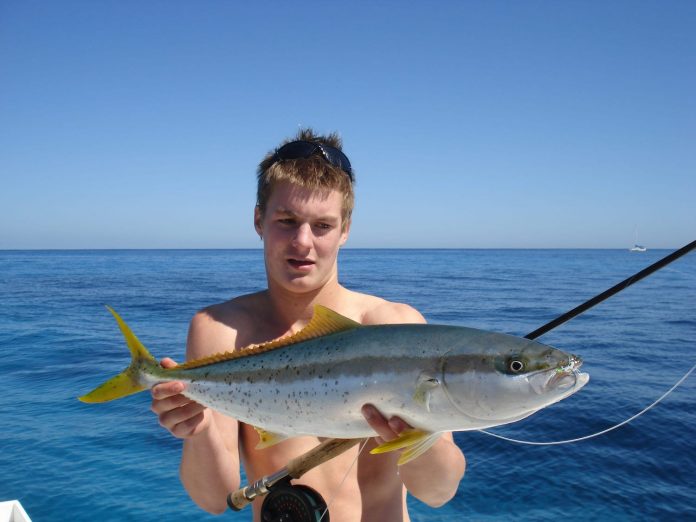by Mike Roennfeldt
Yellowtail kingfish are among my favourite species to catch. They are long, sleek and cool looking creatures with those good looks hiding a brutal, powerful and often underhand nature when hooked. Like few other species, a yellowtail king will actively seek out a way to do you in around reef or structure, sometimes even lying doggo in a cave or hole while you patiently wait for it to swim out, or simply bust off and rig up again.
Getting a good one, say anything over 8kg, is a significant feat on tackle rated at 8kg or less.
The good news is that kings appear to be thriving in metro waters in recent years. Only 30 years ago we didn’t hear much about these great fish, although I suspect many of those that were caught were identified as Samson fish and left at that. The king is a sleeker fish than the Samson, its head is less blunt and its colour generally more silver with, as the name suggests, a yellowish tail and often a yellow stripe running midway along the sides from eyeball to tail. Most kings we see locally are in the 2–4kg range, with a few up around 10kg, but there are much better ones around, occasionally reaching sizes approaching 35–40kg at places like the Abrolhos and Shark Bay’s South Passage.
Jigging for kings was part of the sport fishing revolution on the east coast back in the 1970s, but back then we never really had the concentrations of kings for that style of angling to take off here. Samson jigging – well that turned out to be a whole different story 30 or so years later and with a resurgence of interest in jigging for all sorts of species, we can expect kings to become a prime sportfishing target species in coming years.
Some of the most prolific local yellowtail king spots are around Rottnest, particularly at West End, where schools of small ones can regularly be found by either trolling or berleying up (outside the trolling-only zone). They will happily snap up a sizeable minnow style lure along the lines of a Laser Pro 160, or will take a whole mulie or cube with relish.
Shallow water berleying at other spots around Rotto, often in depths of 8m or less, will sometimes pay welcome dividends. It’s often the case that skippy come in to the berley trail first, followed by kings a few minutes later. If you hook a good one in 8m of water, hang on and cross your fingers, if that’s biologically possible. Good quality 8–10kg spinning tackle is about right for tackling kings of modest size, but even then you probably won’t land as many as you lose.
When it comes to cooking yellowtail kingfish, I like to cut the flesh into relatively thin fillets of less than 1cm thick, roll them in egg and breadcrumbs and shallow fry in oil. Don’t overcook though as they can dry out. Serve with salt and pepper and a squeeze of lemon and get ready for the compliments.
Alternatively, thinly sliced kingfish fillets, around 5mm thick, make for superb sashimi. Recipes for a suitable dipping sauce are readily available online.



































